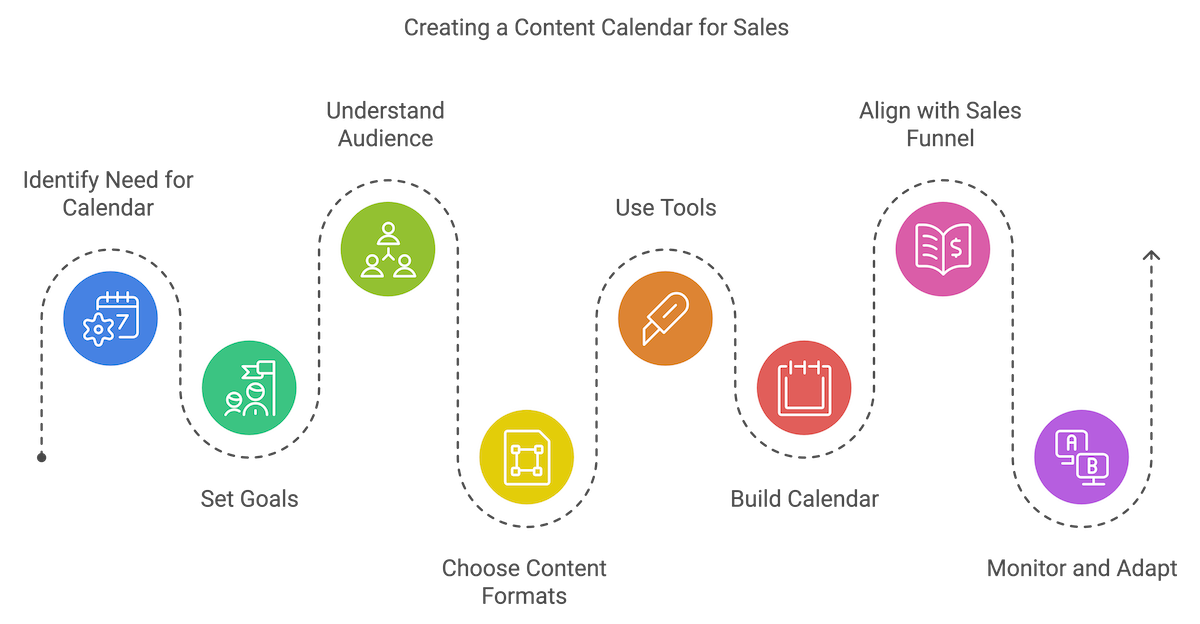How to Create a Content Calendar That Drives Sales
By: Hayden Jarman

Struggling to organize your marketing efforts?
Without a clear plan, even the best ideas can fall flat. A content calendar isn't just a tool; it's a system to help you engage your audience, grow your brand, and drive sales.
Let's break down how to build a content calendar that delivers results and makes your marketing work smarter, not harder.
Table of Contents:
- Why a Content Calendar Matters
- Set Your Goals
- Understand Your Audience
- Pick the Right Formats
- Use the Right Tools
- Build Your Calendar
- Align Content With the Sales Funnel
- Monitor and Adapt
- Make Your Content Pop
- Tackle Common Challenges
- FAQs
- Final Thoughts
🧩 Are You Maximizing Your Content’s Sales Potential? 🔍
Evaluate your current content calendar strategies and get personalized recommendations for improvement!
Why a Content Calendar Matters
Creating a content calendar isn't about filling up a spreadsheet. It's about crafting a strategy to hit measurable goals.
- Consistency wins. A calendar ensures your audience sees regular updates, keeping your brand top of mind.
- Time-saving is key. Planning eliminates last-minute scrambling for ideas.
- Revenue growth is real. 58% of B2B marketers say content marketing contributed to sales last year, up from 42%.
Using a calendar lets you stay ahead of your competition while making the most of every piece of content you create.
Set Your Goals
Before you even think about specific content ideas, get crystal clear on your objectives.
Are you looking to drive traffic, generate leads, or increase conversions? Each goal shapes the kind of content you'll create.
| Goal | Metric |
|---|---|
| Website traffic | Page views, time on site |
| Lead generation | Email sign-ups, form fills |
| Revenue growth | Sales, conversion rates |
Tools like Google Analytics can help track performance. For example, analyze high-traffic posts like SEO vs. PPC: Which Channel Will Work Better? to see what content drives clicks and engagement.
Understand Your Audience
Your content needs to meet your audience where they are. Build detailed personas to figure out who you're talking to and what they need.
Ask these key questions:
- What challenges do they face that your product solves?
- Where do they spend their time online?
- What type of content resonates most?
Experts like Neil Patel and Ann Handley stress the importance of aligning content with audience needs. Without this alignment, even great content can fall flat.
Pick the Right Formats
Different content formats work better at different stages of the customer journey.
Here's what the data shows:
- 95% of marketers focus on social media content.
- 89% prioritize blog posts to drive traffic and educate.
- 81% use email newsletters to nurture leads.
Visual content is also gaining traction. 56% of marketers are creating more image-based assets like infographics and videos.
For inspiration, look at how posts like How to Improve Lead Quality With SEO deliver value with actionable insights.
Use the Right Tools
Managing a content calendar is easier with the right tools.
Here's a quick guide to the best ones:
- Trello: Visual task management for teams.
- Hootsuite: Social media scheduling and analytics.
- Google Sheets: Simple, collaborative, and free.
Pair these tools with Google Analytics to track what's working and refine your approach over time.
Build Your Calendar
Once you know your goals, audience, and tools, it's time to put everything into a calendar.
Start with these steps:
-
Set your publishing cadence.
Decide how often to post on each channel. For instance:- Blog posts: Twice a week
- Social media: Three times per week
- Email campaigns: Twice a month
-
Plan your topics.
Brainstorm ideas tied to audience pain points or trends. For example: -
Assign deadlines.
Use tools like Trello to keep your team accountable.Content Piece Deadline Assigned To Blog: Why Schema Is Important Next Tuesday Digital Marketing Specialist Instagram Carousel Friday Social Media Manager
Align Content With the Sales Funnel
Your content calendar should map to the customer journey, guiding potential customers from discovery to decision.
Here's how to break it down:
- Awareness: Blog posts, social media, infographics.
- Consideration: Email campaigns, how-to guides.
- Decision: Landing pages, product pages.
Repurpose top-performing content into new formats to maximize its impact. For instance, take insights from How to Spot Fake Ads on Facebook and turn it into a LinkedIn post or email tip series.
Monitor and Adapt
A content calendar isn't a "set it and forget it" tool. You need to monitor performance and adjust your strategy as needed.
Key metrics to track:
- Traffic: Are your posts driving visitors?
- Engagement: Are people sharing, commenting, or clicking?
- Conversions: Is your content turning readers into customers?
Tools like Google Analytics can show where your audience is coming from and what's resonating most.
Make Your Content Pop
Your content needs to stand out in a crowded space.
Follow these tips to keep it engaging:
- Use visuals like infographics to break up text.
- Write like you're talking to a friend—skip the jargon.
- Offer real value by solving problems or answering questions.
For example, How to Rank a Website With Multiple Locations simplifies complex strategies into actionable steps, making it easy for readers to apply.
Tackle Common Challenges
Creating a content calendar comes with its own set of challenges.
| Challenge | Solution |
|---|---|
| Not enough time | Use tools like Hootsuite to schedule posts in advance. |
| Struggling to generate ideas | Analyze your competitors' content or run audience surveys. |
| Inconsistent publishing | Automate reminders and deadlines using Trello. |
FAQs
How far ahead should I plan my calendar?
Plan at least three months ahead, but leave room for flexibility.
Do I need expensive tools to start?
No, free tools like Google Sheets are more than enough for beginners.

Final Thoughts
A content calendar is your secret weapon for turning content into revenue.
It helps you stay consistent, align your efforts with goals, and engage your audience with the right message at the right time.
Keep testing, refining, and improving your approach. The more intentional your strategy, the bigger the results.
Related Posts:
- Understanding Google’s Local Pack: How to Get Featured
- Google Business Profile FAQs: Everything You Need to Know
- The Best Google Ads Extensions to Boost Your Click-Through Rates
- How to Leverage Facebook Groups for Local Business Leads
- How to Use AI to Write Better Social Media Captions
- How to Optimize Google Reviews to Attract More Customers
- LinkedIn for B2B Marketing Success
- How to Conduct a Social Media Audit (w/ "Audit Readiness" Quiz!)
- Creating a Content Calendar for Consistent Posting
- The Importance of Mobile Optimization in 2024
- Data Privacy Regulations: What Marketers Need to Know
- The Role of Chatbots in Enhancing Customer Service
- SEO for Small Business: The Ultimate Guide to Getting Found Online
- The Role of Keyword Clustering in Modern SEO

